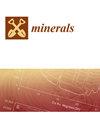Extraction Kinetics of Rare Earth Elements from Ion-Adsorbed Underclays
IF 2.2
4区 地球科学
Q2 GEOCHEMISTRY & GEOPHYSICS
引用次数: 0
Abstract
Citric acid has been identified as an environmentally sustainable organic acid capable of leaching up to ~30% of easily accessible REEs from underclay material. An analysis of the leaching profiles was performed to discern the reaction rates, extraction efficiencies, and potential leaching mechanisms of REEs and cations of interest from ion-adsorbed underclays. The initial leaching stage follows a slow intraparticle diffusion mechanism followed by a second stage controlled by a mixed diffusion regime. The leaching profiles of Ca and P were similar to those of REEs, suggesting that REEs are most likely derived from mineral surfaces such as hydroxyapatite or crandallite rather than predominately from underclays. Fitting to a modified diffusion control model found diffusion-controlled leaching to be the primary mechanism whereas non-diffusive mechanisms made up about 22% of the extracted REEs. Gangue cations associated with underclays had less non-diffusive leaching than REE species, indicating that their leaching kinetics may be dominated by diffusion from within the material or potentially from product layer formation. Fitting to Boyd plots further indicated that REEs were leached following intraparticle diffusion control. These results have important implications for the development of more efficient and sustainable methods for extracting REEs or critical minerals from alternative feedstocks.离子吸附下黏土中稀土元素的萃取动力学
柠檬酸已被确定为一种环境可持续的有机酸,能够从粘土下材料中浸出高达30%的易获取的稀土元素。对浸出剖面进行了分析,以辨别反应速率、萃取效率以及从离子吸附的粘土下提取稀土元素和阳离子的潜在浸出机制。初始浸出阶段遵循缓慢的颗粒内扩散机制,其次是由混合扩散机制控制的第二阶段。Ca和P的浸出剖面与稀土相似,表明稀土最可能来源于矿物表面,如羟基磷灰石或辉橄榄石,而不是主要来自粘土下。拟合改进的扩散控制模型发现,扩散控制浸出是主要机制,而非扩散机制约占提取稀土元素的22%。与稀土元素相比,与下粘土相关的脉石阳离子的非弥漫性浸出较少,这表明它们的浸出动力学可能受物质内部或产物层形成的扩散控制。对Boyd图的拟合进一步表明稀土元素是在颗粒内扩散控制下浸出的。这些结果对开发从替代原料中提取稀土或关键矿物的更有效和可持续的方法具有重要意义。
本文章由计算机程序翻译,如有差异,请以英文原文为准。
求助全文
约1分钟内获得全文
求助全文
来源期刊

Minerals
MINERALOGY-MINING & MINERAL PROCESSING
CiteScore
4.10
自引率
20.00%
发文量
1351
审稿时长
19.04 days
期刊介绍:
Minerals (ISSN 2075-163X) is an international open access journal that covers the broad field of mineralogy, economic mineral resources, mineral exploration, innovative mining techniques and advances in mineral processing. It publishes reviews, regular research papers and short notes. Our aim is to encourage scientists to publish their experimental and theoretical results in as much detail as possible. There is no restriction on the length of the papers. The full experimental details must be provided so that the results can be reproduced.
 求助内容:
求助内容: 应助结果提醒方式:
应助结果提醒方式:


